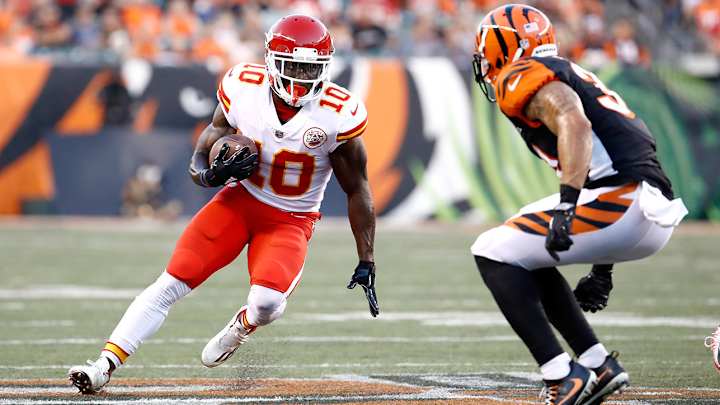Kansas City Chiefs: 10 Things You Need to Know

1. The plan is for Tyreek Hill to be an everydown player in 2017. This can fundamentally change the makeup of Kansas City’s offense. Hill can align anywhere as a wide receiver (including up on the line by himself on the weak side, Dez Bryant or A.J. Green style). He’s also dangerous in the backfield and he’s even more dangerous on gadgetry, which is a big part of Andy Reid’s brilliantly schemed misdirection-based offense.

2. Kansas City’s passing game is unique because it doesn’t rely on wide receivers winning one-on-one outside. (That’s why the expensive Jeremy Maclin was let go.) The scheme is more about route combinations creating opportunities for tight ends and running backs. This diminishes the considerable advantage of cornerbacking talent that division rivals Denver and the Chargers have, and it forces linebackers and safeties to make plays in coverage. Naturally, the throws that come here are more about timing and less about velocity and precision accuracy, which is why Alex Smith, a caretaker QB (call him a “point guard QB,” if you feel that’s more respectful), is a fine fit.
Tyreek Hill Is Fast Becoming a Star
3. The nature of this highly schemed offense also makes it unconducive to a raw QB like first-round rookie Patrick Mahomes. Don’t be surprised if Mahomes learns from the bench over his first two seasons. He played a very undisciplined and unstructured brand of football at Texas Tech. That’s the opposite of how Reid wants to play.
4. Running back Spencer Ware, who unfortunately is now out for the season with a knee injury, led the team in yards per catch last season with 13.5. There were two reasons for that: (1) The Chiefs have a brilliant and expansive screen game. They employ running backs not just on the staple backfield screens but also some of the tight end and even receiver screens. And (2) K.C. will occasionally send a back on a deep downfield route out of the backfield. This is so unusual that most defenses don’t have a response for it—they’ve never needed one. Ware was really productive on backfield vertical routes early last season.
5. The two best “three-tight end” packages in football belong to Washington and Kansas City. What do those teams have in common? An athletic, refined route-running tight end who can line up anywhere (Jordan Reed and Travis Kelce), and a subtly athletic No. 2 tight end who can also line up anywhere (Vernon Davis and Demetrius Harris.) Remove Kelce and this is a significantly less potent offense.
6. No defense that has ever allowed less than 20 points a game has given up more yards than the 2016 Chiefs did, which speaks to K.C.’s dependency on big plays. Their 18 interceptions were tied with the Ravens and Chargers for the most in the league. What’s incredible is they did this in a matchup-based scheme. When the Chiefs aren’t playing man coverage, they play an assertive matchup zone that often plays out like man coverage. Man-to-man defenders typically don’t get as many interceptions because their eyes are on their receiver, not the quarterback and ball.
7. The leader in those interceptions, Marcus Peters (six), is fast becoming one of the best corners in football. The aggressive 24-year-old is still a bit of a double-edged sword, prone to giving back some of the big plays he creates. But with each passing week, he’s gotten more disciplined. If he stays on his current track, he’ll be in the discussion of “best all-around corner in football.” His effectiveness in off-coverage technique makes him lethal in both man and zone.
The 10 most important players on the Kansas City Chiefs
8. Because of all the matchup principles in Kansas City’s coverages, flexibility at safety is key. Eric Berry and Ron Parker can both cover tight ends man-to-man. (Parker, a former corner, can also cover certain slot receivers.) In this scheme, a safety must know how to convert his zone coverage into vertical man-to-man coverage, and he must have a feel for playing to his inside help.
9. Second-year defensive lineman Chris Jones has a chance to be special. His initial quickness and raw strength are tremendous.
10. It’s hard to fault Tamba Hali for wishing he’d played more in the playoff loss to Pittsburgh. (Just before training camp, Hali tweeted his complaints about seeing only seven snaps in that game.) But it’s also hard to fault defensive coordinator Bob Sutton for not getting Hali more reps. Sutton has two other superb edge players to rotate: Justin Houston (when healthy, of course) and Dee Ford. Both have the quickness and bendability to beat blockers with an athletic bull-rush. Hali, at age 33, is still a high-octane presence, and his bull rush, thanks to sound mechanics, has always been terrific. Overall, it’s an embarrassment of riches on the edge in Kansas City. Now the Chiefs just need all three men to be healthy at the same time, which hasn’t been the case often enough.
• Question or comment? Email us at talkback@themmqb.com.
